
Compass coding (tech-free version)
You’ll need
- Compass
- Scissors
- Masking tape
To watch in full screen, double click the video
Before you begin
- Mark out a grid on the floor using masking tape or pieces of paper.
- Print out a copy of the ‘Notes and handout’ pack.
- Place the start triangle and the camp symbol somewhere on the grid.
- Cut out the compass cards.
Give clear instructions
- Everyone should think about the way we tell computers what they should do. We have to give them very clear instructions. Why might this be important? (Computers will do exactly what you tell them to, even if you get it wrong.) What could be the problem if your instructions are unclear?
- Everyone should discuss the ways you can give instructions when navigating. We use a compass, with four directions (North, East, South, West). How can giving compass directions be the clearest way of giving instructions?
- Use compasses to find North, East, South and West.
- Explain that we will be using these directions to move a ScoutBot from one part of the floor grid to another, from the start to the camp.
- In the language of computers, the compass directions are the code for instructing the computer. If the code is wrong and does not get the ScoutBot to the camp, we say there is a ‘bug’ in the code. To resolve the issue, the code needs to be ‘debugged’.
Have a go
- One person should be the ScoutBot. Everyone else is a programmer.
- Programmers should give the appropriate commands (North, East, South, West) to make the ScoutBot travel one square at a time from the start to the camp. Programmers should use the compass cards to plan a complete program, and then read it out to the ScoutBot who should move through it.
- The ScoutBot should follow the instructions even if they are incorrect and not taking them towards the camp. If there’s a mistake (or bug), a programmer can shout ‘halt!’ to stop the ScoutBot. The programmers should debug the code by trying again from the start.
- Create more challenging routes by using the rocks and firewood symbols to create obstacles. The ScoutBot cannot step on squares where there are rocks. When the ScoutBot reaches a square with firewood, they must be programmed to stop and collect it.
Reflection
This activity helped you to develop your programming skills. This could help you to understand how computers, tablets and smartphones work and what they do. Why do you think it could be useful to understand computers? What kind of jobs involve working with computer programming?
This activity was also about solving problems, just as computer programmers do. How did you find a bug in your code? How did you correct, or debug, the code? Was it better to choose a short route with fewer instructions or a really long route? Was it possible to find a bug before you instructed the ScoutBot?
Safety
All activities must be safely managed. You must complete a thorough risk assessment and take appropriate steps to reduce risk. Use the safety checklist to help you plan and risk assess your activity. Always get approval for the activity, and have suitable supervision and an InTouch process.
- Active games
The game area should be free of hazards. Explain the rules of the game clearly and have a clear way to communicate that the game must stop when needed. Take a look at our guidance on running active games safely.
Place the start and camp sheets close together to make the activity easier. Introduce rocks as an obstacle to be avoided and add firewood for the ScoutBot to collect to make the activity more challenging. Try blindfolding the ScoutBot to force them to follow instructions more accurately.
Use the tabletop version of this activity if space is an issue, or try a digital version by typing rpf.io/compass into the address bar of your internet browser.
All Scout activities should be inclusive and accessible.
Young people could create 'debugging' challenges for each other to solve, as part of the Navigator Staged Activity Badge.
Showcase your tech projects with other creators in the UK and across the world! Check out the Coolest Projects webpages to take part for free from February, or join the celebratory livestream with announcement of the judges’ favourite projects in June. We’d love to see Scouts of all ages involved so please mention you’re a Scout when you register!

